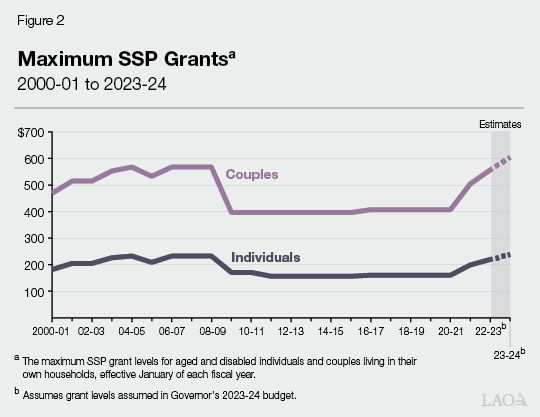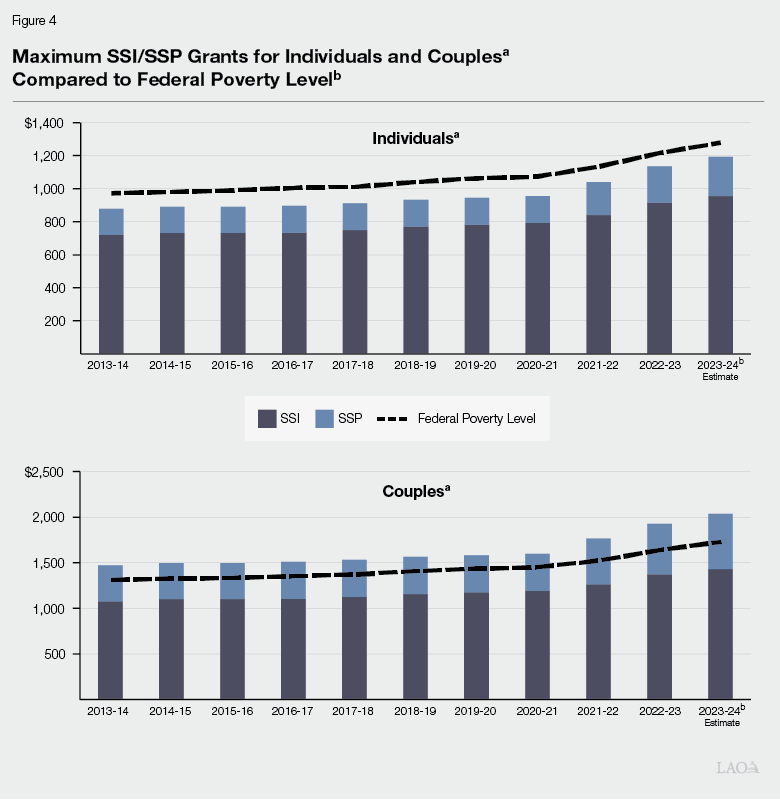LAO Contact
February 24, 2023
The 2023-24 Budget
Supplemental Security Income/State Supplementary Payment (SSI/SSP) Program
This post summarizes the Governor’s budget assumptions and proposals related to the SSI/SSP program.
Background
The SSI/SSP program provides cash grants to low-income aged, blind, and disabled individuals. Grant levels for SSI/SSP are determined by both the federal government and the state. Specifically, the federal government pays for the SSI portion of the grant while the state pays the SSP portion of the grant. For 2023-24, the Governor’s budget proposes $3.5 billion from the General Fund for the state’s share of SSI/SSP—an increase of $244 million (7 percent) over estimated 2022-23 expenditures. This increase would bring total program funding to $11.4 billion ($3.5 billion from the General Fund and $7.8 billion federal funds) in 2023-24. The primary driver of this increase is the full-year cost impact of the 10.3 percent SSP grant increase that took effect on January 1, 2023, and the half-year impact of the proposed 8.6 percent grant increase in January of 2023-24.
Governor’s Budget Caseload Assumptions
Governor’s January Budget Assumes SSI/SSP Caseload Continues to Decline. The SSI/SSP caseload grew at a rate of less than 1 percent each year between 2011-12 and 2014-15. Beginning in 2015-16, however, SSI/SSP caseload began to slowly decline at an average rate of 1.5 percent each year. As shown in Figure 1, the Governor’s budget projects that caseload will decrease by 1.5 percent in 2022-23 and 1.9 percent in 2023-24, which is in line with past caseload trends. We are working with the Department of Social Services to better understand the reasons behind the continued decline in SSI/SSP caseload and will provide further comments at the time of the May Revision if necessary.

Governor’s 2022-23 and 2023-24 SSI/SSP Grant Assumptions
Federal Government Required to Provide Annual COLA to SSI Grants, While State Has Option to Provide Annual COLA to SSP Grants. The federal government is required to provide an annual cost-of-living-adjustment (COLA) each January to the SSI portion of the grant. The federal COLA increase is based on the Consumer Price Index for Urban Wage Earners and Clerical Workers (CPI-W). In years that the CPI-W is negative (as was the case in 2010, 2011, and 2016), the federal government does not decrease SSI grants, but instead holds them flat.
The state has full discretion over whether and how to provide increases to the SSP portion of the grant. Until 2011, the state had a statutory annual COLA. These COLAs generally reflected whole-grant COLAs. Whole grant COLAs worked by applying the California Necessity Index (CNI) to the total SSI/SSP grant. If the federal SSI COLA was not enough to increase total SSI/SSP grants to CNI-adjusted levels, then the SSP portion of the grant was increased by the remaining amount. (Despite the state statutory COLA, there were many years prior to 2011 when the COLA was not provided due to budget constraints.) After the Great Recession, SSP grants occasionally were increased by applying the CNI only to the SSP portion of the grant (in 2016-17 and 2021-22). Additionally, the 2018-19 budget included legislation to provide annual state COLAs beginning in 2022-23, to the extent that funding is provided in future budget years. (We understand that the Governor’s multiyear grant projections do not include an annual state SSP COLA in 2022-23 and onwards.) We note that, although not COLAs, SSP grant increases were provided in 2021-22 and 2022-23 and are described more fully below.
During Constrained Budget Environment, SSP Grants for Individuals and Couples Were Reduced to Federally Required Minimum… The state is required to maintain SSP monthly grant levels at or above the nominal levels in place in March 1983 ($156.40 for SSP individual grants and $396.20 for SSP couple grants) in order to receive federal Medicaid funding. As shown in Figure 2, during the Great Recession, the state incrementally decreased SSP grants for individuals and couples until they reached these minimum levels in June 2011 and November 2009, respectively.

…However, SSP Grants Were Increased in 2016-17, 2021-22, and 2022-23. Since the past SSP grant reductions, grants for individuals and couples have been increased three times—in 2016-17 (by 2.76 percent), 2021-22 (by 23.95 percent), and in 2022-23 (by 10.3 percent). The 2021-22 and 2022-23 SSP grant increases were based on a statutorily required calculation that required the Department of Finance to estimate what grant increase could be supported for a total cost of $291 million in 2021-22 and a total cost of $150 million in 2022-23 (estimated to be about $300 million in 2023-24). Based on this calculation, SSP grants increased by 23.95 percent on January 1, 2022 (increasing grants by $39 for individuals and $98 for couples), and by 10.3 percent on January 1, 2023 (increasing grants by about $21 for individuals and $52 for couples).
Governor’s January Budget Includes Federal SSI COLA Estimates and a 2023-24 SSP Grant Increase. Figure 3 demonstrates how actual maximum SSI/SSP grant levels in 2021-22 compare to the maximum SSI/SSP grant levels in 2022-23 and the administration’s estimates of the proposed 2023-24 SSP grant increase. The projected changes in maximum SSI/SSP grant levels in 2023-24 are due to the proposed increase in the SSP grant and the estimated increase in the federal SSI COLA.
Figure 3
SSI/SSP Monthly Maximum Grant Levelsa—
Governor’s Proposal
|
2021‑22 |
2022‑23 |
2023‑24b |
|
|
Maximum Grant—Individuals |
|||
|
SSI |
$841.00 |
$915.00 |
$955.00 |
|
SSP |
199.21 |
219.73 |
238.62 |
|
Totals |
$1,040.21 |
$1,134.73 |
$1,193.62 |
|
Percent of federal poverty levelc |
92% |
93% |
93% |
|
Maximum Grant—Couples |
|||
|
SSI |
$1,261.00 |
$1,372.00 |
$1,432.00 |
|
SSP |
504.64 |
556.62 |
604.49 |
|
Totals |
$1,765.64 |
$1,928.62 |
$2,036.49 |
|
Percent of federal poverty levelc |
116% |
117% |
118% |
|
aThe maximum monthly grants displayed refer to those for aged and disabled individuals and couples living in their own households in January of fiscal year. bReflects administration’s estimate of the January 2024 federal cost‑of‑living adjustment for the SSI portion of the grant. Also reflects proposed SSP grant increase in January 2024. cCompares grant level to federal poverty guidelines from the U.S. Department of Health and Human Services up to 2022‑23. Estimates of federal poverty guidelines for 2023‑24 are based on Consumer Price Index for All Urban Consumers projections. The 2023‑24 federal poverty guidelines will not be finalized until Fall 2024. |
|||
Increase in 2023-24 Driven by Proposed SSP Grant Increase and Estimated Federal COLA. The Governor’s budget estimates that the federal COLA for the SSI portion of the grant will be 4.4 percent in 2023-24, increasing maximum SSI grants by $40 for individuals and $60 for couples on January 1, 2024. (The actual federal SSI COLA will not be known until fall 2023.) Additionally, the Governor’s budget proposes an increase in the maximum SSP grants on January 1, 2024. This increase will cost $146 million in 2023-24 (increasing to nearly $300 million in 2024-25). The administration estimates this could support an 8.6 percent SSP grant increase (increasing SSP grants for individuals by about $19 and couples by about $48). (This increase is not proposed to be codified in statute, however.)
Despite Recent and Future SSI and SSP Grant Increases, Grant Levels Remain Below Federal Poverty Level (FPL) for Individuals. As shown in Figure 4, the maximum combined SSI/SSP monthly grant amount for individuals (the bulk of the SSI/SSP caseload) and couples had been increasing on average by 1.2 percent annually since January 2014—predominantly due to the provision of federal SSI COLAs. In 2022, maximum SSI/SSP grant levels for individuals and couples experienced a more significant increase (an overall increase of 9 percent and 10 percent, respectively) due to the highest in history one-time SSP grant increase (23.95 percent) and a historically high federal SSI COLA (5.9 percent) taking effect on January 1, 2022. Additionally, in 2023, maximum SSI/SSP grant levels for individuals and couples increased again—by about $95 and 9 percent overall for individuals and $162 and 9 percent overall for couples due a one-time SSP grant increase (10.3 percent) and a higher-than-usual SSI COLA (8.8 percent). Despite these most recent grant increases, current maximum SSI/SSP grant levels for individuals remain below the FPL, while grant levels for couples remain above the FPL. Moreover, despite the proposed 8.6 percent SSP grant increase on January 1, 2024, maximum SSI/SSP grant levels for individuals are projected to remain below the FPL in 2023-24.

May Wish to Consider Establishing 2023-24 Grant Increase in Statute. All the recent SSI/SSP grant increases have been established in the law. For example, both the 2021-22 and 2022-23 grant increases included budget-related legislation stating that the grant increase would be the highest amount possible within the budget allocation provided. The statute also established the methodology that would be used to determine that grant amount (including a requirement for Legislative review of that methodology). We understand that the administration does not plan to propose legislation for the 2023-24 SSP grant increase. From our discussions with the administration, we understand their intent is to have the 2023-24 grant increase amount be determined using the same methodology as was used in the prior two grant increases. The Legislature may wish to consider establishing the increase statutorily—including a requirement that the final amount, and the methodology used to determine it, be subject to legislative notification and review.
